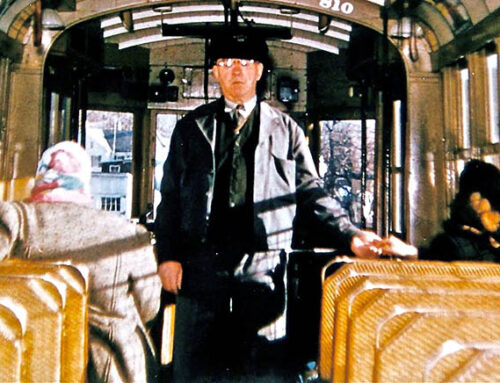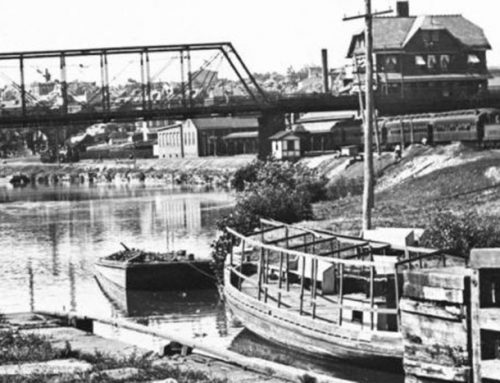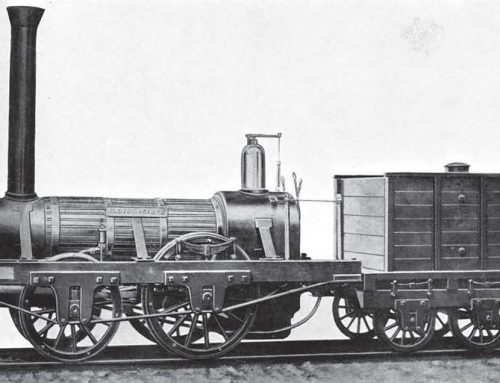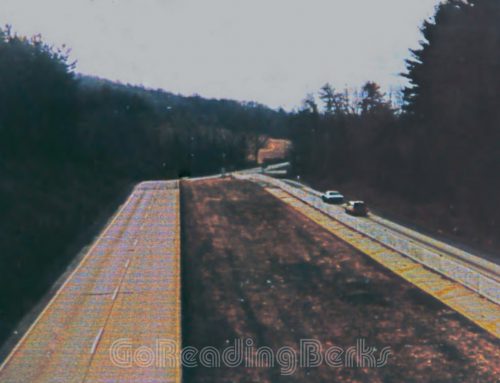The first air show at Reading, PA was held during dedication ceremonies for the newly built municipal airport in 1939.
As early as 1934 the site for the Reading Municipal Airport was selected. The land in Bern Township was acquired by purchases made by the City and County at a cost of $40,682. Work was started on the 180-acre tract in August 1936 as a WPC project, toward which the government contributed approximately $1,000,000 and the City $500,000. The fireproof hangar was erected through a CWA project at a cost of $75,000.
Below: Construction photo of Reading Municipal Airport, 1937.

The field was dedicated during a two-day ceremony on October 7 and 8, 1939 which attracted 103,000 spectators. At least half as many, it was estimated, saw the air show from more distant points of vantage.

The event, featuring parachute jumps, sky writing, racing, stunting, and a demonstration by a 1910 Curtiss pusher, brought to Reading some of the nation’s leading aviation officials, military pilots, acrobatic fliers and planes from three of the country’s biggest airlines TWA, American and United.
Below: Image Gallery – Reading Air Show, 1939 – Touch or Click
From the air, the crowd was impressive. In addition to the thousands around the airport, additional thousands of automobiles were parked along highways. In fields, and on hilltops within a radius of six or seven miles of the port and every road leading to the field, even the country dirt roads that are seldom used were clogged with traffic.
Below: Bird’s-eye view of Reading Municipal Airport just as a huge crowd of 100,000 visitors was breaking up at the conclusion of the second day’s air show, Oct. 8, 1939.

The 1939, 1940 and 1941 air shows were conducted by the airport authority. In 1941, the Army took over and enlarged the facility by at least six times. After a wartime hiatus, the Reading community and flying clubs, with input from Reading Aviation Service, cobbled a modest show. Then, in 1949, Reading Aviation Service took the reins. Reading Aviation Service, a fixed base operation providing aircraft service and supplies, envisioned a grand event to package their product.
Below: Reading Municipal Airport, 1941.

Reading Aviation Service was purchased by Robert H. Breithaupt and Alfred M. Bertolet in 1941 when it was a sales and maintenance operation for light aircraft, dealing in little Ercoupes and Luscombes. They taught civilian pilots to fly and later got a U.S. Army contract for military pilot training. After World War II, Reading Aviation Service founder Brooks L. McElroy rejoined the company. In 1949 the trio launched the National Maintenance & Operations Meeting, or, as it was known for decades, the Reading Air Show.
The Reading Air Show was considered the best show in the world. But it was a trade show. It wasn’t about selling balloons to the kids.
At its peak, Reading boasted a daily professional registration of 12,000. Its roster of exhibitors was a roll call of the big guns of aviation: Rockwell International, Grumman American Aviation, Boeing Vertol, AVCO Lycoming, Bell Helicopter Textron, Aerospatiale Helicopter, Pratt & Whitney, and Beechcraft, Piper, and Cessna. It was also a favorite venue for suppliers to the industry: AC Spark Plug, Teledyne Battery, Marathon Battery, Alcor, AVEMCO, Collins Avionics, BF Goodrich, Texaco, Mobil, Esso (later Exxon), and Shell. From humble beginnings in the 1940s, the show grew until in the late 1960s and ’70s, it rivaled the biannual Paris show in attendance, if not in prestige.
The original Reading show was founded by Reading Air Service to promote its maintenance business. Awards were given to the best-maintained airplanes at the show. The initial shows were a thank-you party for the best Reading Air Service customers who invited them for the Pennsylvania Dutch food. There was no airshow, just FAA dignitaries and seminars. The first performances were simply ad hoc presentations by some of the pilot-customers who happened to have flown their airplanes to the site. They had no schedule of acts. It was largely military surplus. Everyone who had an airplane after the war suddenly became a barnstormer.
Initially the show was free, and within five years exhibitors were charged a setup fee. Eventually it became a week-long event, and by the mid-1960s, commercial registration was $5 a day or $10 for the week.
Below: Reading Air Show, late 1940s.

By 1970, more than 200 companies were returning every year in the first week of June to wedge their exhibits into 8 to 16 foot-wide booths set up in surplus Army barracks. Up to 650 airplanes parked on the ramp. Exhibitors would pay $3,500 for a hospitality chalet for the week – mobile homes with porches and canopies. Chalets were more an excuse for a bar. All the major manufacturers served free beer. There were open houses at the motels too. In those days, aviation was a hard drinking crowd.
Reading had taken on a life of its own. It was a “transistorized Paris,” attracting the same big deal makers but cramming them into a small, come-as-you-are city, where the specialties were Macadamia nut pancakes, not coq au vin. The show is remembered today more for its social atmosphere and the aura of deal making than for the deals themselves. People who attended tell stories of cocktail parties, lawn parties, motel hospitality room parties, and chalet bars. With each memory, you get the equivalent of a roguish wink that tells you this was aviation’s good time for its mostly male sales force, behaving in this eastern Pennsylvania town the way they’d never behave at home.
The trade press loved Reading. Air Progress magazine lent its name to one of the most popular affairs: a cocktail party on the Tuesday night of show week at posh Stokesay Castle. On Wednesday nights, everybody went to a bash at the Reading Motor Inn, hosted by Ziff-Davis, then publisher of Flying and Business and Commercial Aviation magazines.
Exhibitors would return every year for the food and parties, not the airshow. During show week it was like every night was Saturday, a party. You would have large aviation fuel companies like Texaco and Mobil, airplane design companies. This was the day of the three-martini lunch and no end in budget.
Cessna’s representative at the 1978 airshow defended such expense to the Reading Air Show Daily News, saying, “There’s talk about the high costs of attending shows like Reading, but our dealers invite prospects here as their guests and show them some of the models that they might not have in stock. We are convinced that the resulting sales more than offset the cost of the [hospitality] program.”
Each year Reading Aviation Service sponsored an awards competition to promote good maintenance and, indirectly, itself. Initially, the downtown Reading Crystal Restaurant hosted the gala banquet, but it later moved onto the field, along with white-glove catering for 300 and big bands. Cab Calloway was one of the entertainers. Arthur Godfrey came one and later became an honorary show chairman. The chairmanship evolved into a way to pay tribute to aviation heroes: Neil Armstrong flew in his Learjet to chair in 1974. In 1978, T. Claude Ryan of Ryan Aeronautical, builder of the Spirit of St. Louis, presided.
In the 1960s, Reading began booking aerobatic performers to fly at the end of the day, after the product introductions had ended. Air show legends Daniel Heligoin and Montaine Mallet appeared at Reading, flying Cap-l0s as the French Connection.
Below: View of school children sitting on the grass at Reading Air Show, Reading, Pennsylvania, June 1967. Shorts S.C.7 Skyvan Series 2 (A/C No. G-ATGP) visible in background.

In 1966, Reading hosted its first military aerobatics team: the U.S. Navy Blue Angels, flying Grumman F11F-1 Tigers. Two years later, the U.S. Air Force Thunderbirds came to town in F-100D Super Sabres. Then in June 1972, the British Royal Air Force Red Arrows invaded Reading as part of their North American debut, flying Hawker Siddeley Gnats in a formation of nine. And the norms of airshow performance changed forever.
Below: View, from above, of part of the field at Reading Air Show, Reading, Pennsylvania, June 1970.

At the time, the term “energy toward the crowd” hadn’t been coined. Modern airshows set a safety buffer called scatter distance: the product of the airspeed and the altitude the aircraft achieves at the most critical point of a maneuver. It is intended to provide breathing room if plans go astray (as they did in 1988, when Italian air force jets collided as one headed toward the crowd during a performance in Ramstein, Germany, killing 70 spectators and injuring hundreds). Today, flights over a primary spectator area must be straight and level or climbing, and in a direction perpendicular to the forward edge or “showline” of the cluster of fans, never during or while exiting an aerobatic maneuver.
The Red Arrows didn’t care, when in 1972, the team flew their most dangerous maneuvers directly towards the thickest part of the crowd. After performing, they did a flyby within 100 feet of the tower, below the eye level of the tower right over the chalets and VIP crowd. The Red Arrows’ C-130 transport buzzed 150 feet over a line of 7,000 people.
Below: Aerial view of the field at Reading Air Show, Reading, Pennsylvania, June 1972.

Below: View of crowd watching the U.S. Army Silver Eagles aerial demonstration team perform at the Reading Air Show, Reading, Pennsylvania, June 1973.

When the military teams started flying, Reading management initiated a number of procedures that became routine at all air shows. Snow fences were added along show center to prevent jet wash from blowing over the light aircraft parked on the grass. Still, there were mishaps. In 1971 a hovering Harrier pilot burned a hole in the tarmac of Runway 13/31 that persisted through years of patches.
The military demonstrations brought bigger crowds. Show management snagged farm fields each year as temporary lots but provided no paved parking. Local farmers learned to price for what the market would bear.
Below: View of Canadian Air Force Snowbirds Canadair CL-41 (CT-114) Tutor and U.S. Navy Blue Angels Douglas A-4F Skyhawk aircraft lined up, canopies open, at the Reading Air Show, Reading, Pennsylvania, June 1976.

Everyone wanted to jump on the bandwagon of the show’s success. A 15-cent cup of coffee suddenly went for 50 cents. The airport authority parked cars and collected trash, so they also wanted a piece of the action. All the restaurants in town escalated their prices during show week and rooms were twice or more the usual. Still, every motel room was filled, all the way to Pottstown, even at artificial prices.
Arrangements were made for overflow guests to stay in the dormitories of Albright College. Local roads were overwhelmed with traffic, especially at the end of a day, when product demonstrations ended and aerobatic performers took over. Businessmen, leaving the airport after a day of drumming up sales, clashed with incoming public show audiences on narrow two-lane roads.
The infrastructure of Reading, Pennsylvania, was never really ready for this kind of show. That continually worsened and no one in the city took action. When you’ve got an executive with a credit card waiting to take out VIP guests and he can’t get a cab, he remembers and vows not to return.
Gradually, the exhibitors began to withdraw. Bendix passed on booth space in 1978 because like thousands, its representatives couldn’t find a motel. Canadair showed up but decided that 1978 would be the last year.
In 1976, public attendance had mushroomed past 100,000 while paid, professional registration topped 12,800 each weekday. Only one year later, paid entry to exhibits had fallen to 10,108 and the number of exhibits to 163; nearly 100 less than a couple of years earlier. Nonetheless, the show remained a media favorite. Nearly 1,600 journalists turned up – one for every six registrants. Though the decrease in numbers that year was largely due to poor weather, the tumble was assured. Breithaupt and partners started discussing plans to hold “Paris on the Schuylkill,” as some patrons called it, every other year, to alternate with the Paris Air Show. But in 1980, Reading Aviation Service ran its last show.
Below: A Supermarine Spitfire, seen parked adjacent to one of the former U.S. Army Air Force buildings during the 1976 Reading Show, was reportedly owned by actor Cliff Robertson. During the 1970s it was not unusual to have restored World War II aircraft on display during the event. One group known then as the “Confederate Air Force ” (now the Commemorative Air Force) displayed several of their aircraft.

What happened at Reading was textbook trade-show herd mentality. Potential show exhibitors watch the big companies – Boeing, Grumman – to see if they will attend and therefore stamp the show as serious. Some show organizers give quiet incentives to these big companies, knowing that once they sign up, many others will rush in. Without heavyweight exhibitors, customers don’t think the show serious either.
Two years after the original show closed. Reading Aviation Service changed its name to that of its subsidiary Suburban Airlines. Maintenance operations had been winding down, but the airline continued its routes. In 1988, Suburban liquidated the last of the maintenance operation and sold its aircraft and routes to US Airways.
After five years, Reading got a brand-new show – the 1985 Reading Aerofest, staged by the Reading Airport Authority. It continued for several years as a single weekend event, Friday evening through Sunday. The show sponsored its own banquet without the involvement of commercial aviation vendors. Within two years the event had enticed the Thunderbirds to return, but the team had to stage from Harrisburg International Airport, which was 60 miles away but, unlike Reading, had a runway long enough to meet the Air Force’s new minimum of 7,000 feet.
Aerofest’s last show, in 1998, booked the Blue Angels, Ken High and his Super Shockwave jet truck, Robosaurus (which scoops up and crushes cars in his claw), U.S. national aerobatic champion Patty Wagstaff in her Extra 300S, Bobby Younkin in his Beech 18, and the A-10 Thunderbolt II Demonstration Team. Hotel space and parking was still a problem, due to airport development, along with FAA requirements for sterile areas during the performance of military teams.








Leave A Comment